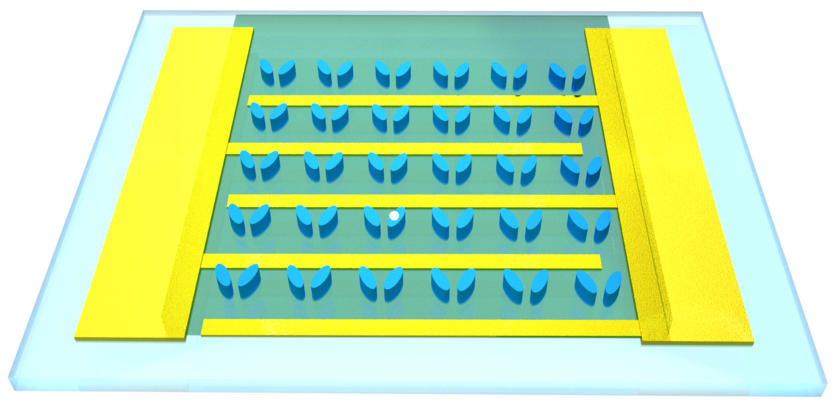Electro-optic modulators regulate the properties of light in response to electrical impulses and are used in a variety of applications ranging from sensing to metrology and telecommunications. The majority of current research into these modulators is focused on applications in semiconductors or in fiber optic systems.
 The modulator consists of a thin layer of an organic electro-optic material (green) deposited on top of a metasurface etched with sub-wavelength resonators integrated with microwave electronics (gold). Image Credit: Capasso Lab/Harvard SEAS
The modulator consists of a thin layer of an organic electro-optic material (green) deposited on top of a metasurface etched with sub-wavelength resonators integrated with microwave electronics (gold). Image Credit: Capasso Lab/Harvard SEAS
Current light modulation in free space technologies is large, slow, static, and inefficient. Scientists from Harvard’s John A. Paulson School of Engineering and Applied Sciences (SEAS) have created a portable and tunable electro-optic modulator for free storage applications that can help regulate light at gigahertz speed. The study was conducted in collaboration with researchers from the University of Washington’s Department of Chemistry.
Our work is the first step toward a class of free-space electro-optic modulators that provide compact and efficient intensity modulation at gigahertz speed of free-space beams at telecom wavelengths.
Federico Capasso, Study Senior Author and Robert L. Wallace Professor, Applied Physics, Harvard John A. Paulson School of Engineering and Applied Sciences
Capasso was also the Vinton Hayes Senior Research Fellow in Electrical Engineering.
The research is published in the journal Nature Communications.
Flat, compact metasurfaces are perfect platforms for regulating light in free space, but most of them are stable, which means they cannot turn on and off, which is a major feature of modulators. Some active metasurfaces can modify light successfully, but only at low rates (a few megahertz).
Short, quick bursts of light on the gigahertz scale are required for applications like sensing and free-space communications.
To efficiently modify the intensity of light in free space, Capasso and his team created a high-speed modulator that combines metasurface resonators with high-performance organic electro-optical materials and high-frequency circuit architecture.
The modulator is made up of a thin layer of organic electro-optic material placed on top of a metasurface engraved with microwave circuitry and sub-wavelength resonators. The refractive index of the electro-optical material varies when a microwave current is applied to it, altering the light intensity passed by the metasurface in nanoseconds.
With this design, we now can modulate light 100 to 1,000 times faster than previously. This speed advance opens new possibilities in computing or communications and the tunability of the metasurface opens up a vast application space for custom-tailored, ultra compact photonics that may in the future be deposited onto any nanoscale free-space optical product.
Ileana-Cristina Benea-Chelmus, Study First Author and Research Associate, Harvard John A. Paulson School of Engineering and Applied Sciences
The researchers now want to test if they can regulate light even quicker and, by altering the architecture of the metasurface, adjust other properties of light like phase or polarization.
The Harvard Office of Technology Development has protected the intellectual property related to this project.
Journal Reference:
Benea-Chelmus, I-C., et al. (2022) Gigahertz free-space electro-optic modulators based on Mie resonances. Nature Communications. https://www.nature.com/articles/s41467-022-30451-z
Source: https://www.seas.harvard.edu/